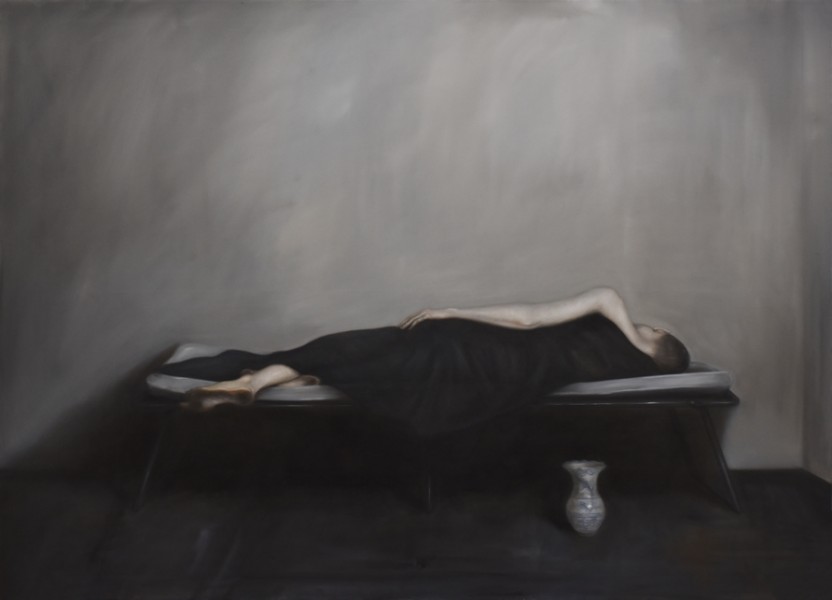RX&Slag is pleased to present Last Rites, the debut solo exhibition in Paris of New York-based artist Paul Joseph Vogeler. The exhibition will feature new paintings by the artist, known for his examinations of spirituality, sensuality, and the existential, through poignant depictions of the human form, animals, and still life.
In a contemporary world of identity politics and culture wars, Vogeler seeks to paint the truth of our existence, a finite nature constantly at odds with itself. He dives into the art of the Catholic Revival bringing complex timeless themes into contemporary manifestation. Vogeler searches for a deeper meaning in a world caught up with secular materialism, looking toward a previous generation of painterly authenticity and mastery of craft. These paintings are dark and subliminal, and the solitary figures find themselves within meditative psychological spaces; but there is hope, there is light amidst the darkness, and Vogeler invites you to partake.
Last Rites delves into Vogeler’s fascination with existence and humanity’s unchanging, dichotomous nature, both fallen and Divine–his narratives explore a timeless, infinite universe and life beyond death. Vogeler is a practicing Catholic who has studied and spent many years with both the Dominican and Franciscan Friars, often finding himself in the middle of two coinciding philosophies under one Church. In his painting Entombment, we are reminded of Christ’s entombment in the cave after his Crucifixion. Vogeler’s self-portrait is the focal point of this oil painting, which depicts the artist asleep on a simple cot within his own cavern—his atelier. The artist had recently attended a lecture on the Shroud of Turin and was fascinated by the phenomenal event of the Resurrection that imprinted a depiction of Christ onto his burial shroud. The vessel in the foreground, a traditional Spanish ceramic, is symbolic of a soul, our bodies containing such, and the forthcoming reunification of body and soul at the end of time. The symbolic quietude embodies rest: of the painter’s literal rest from the act of creation, but also of one’s soul’s eternal rest in a realm beyond.
The Tomb of Saint Francis was inspired by the artist’s recent travels and exhibitions in Madrid, particularly Vogeler’s experience beholding works by Catholic painters Zurbarán, Ribera, and Velasquez, who worked amidst a tide of Reformationists. Vogeler was also deeply impacted by the haunting imagery of Goya, especially his series The Disasters of War, which consists of beautifully grotesque etchings that remind the viewer of humankind’s often hellish nature. In this painting, Saint Francis grips a skull, looking downward, reflecting upon his own mortality. The skull, as well as the ceramic vessel often found in the artist’s paintings, are Memento Mori, a reminder of the fact that what we do here resonates in eternity. Francis’s shadowy interior is intensely psychological, the light seems to come from an outside source, but also from within. He is shown without shoes, the Franciscans known for their vow of poverty. We are brought into the catacomb not only of Francis’s final resting place, but also of his mind and soul: of human reflection, and of those moments of weakness when questioning the Divine Plan.
Vogeler examines traditional still life with Vessel with Hare and Still Life with Peaches and Pewter Plate; the Carpenter’s Chalice offers us an ulterior vessel for The Last Supper, this time a simple clay pot. The pewter plate, along with other silver objects in his collection, were family heirlooms collected by his mother and given to her son to maintain and relinquish through future generations. The artist utilizes them to construct a traditional still life of yellow peaches, a summer stone fruit set upon antiquated pewter, a moment of beauty within atrophying time. The fruit will brown and rot, its flesh returning to the soil, while its metallic counterpart will live on.
In Inferno Vogeler paints Dante, the protagonist of Aligheiri’s masterpiece. Dante’s gaze is turned away from us: we view his torment and journey through the Inferno. The painting, The Fool is a self-portrait of the artist, having painted himself like a Velasquez buffoon, projecting the insecure self-lamentation
many painters succumb to while trying to master their craft. Also among this collection of paintings is the element of fetish shown initially in Birth and Angst, where female figures are unable to be seen or to speak. In the painting Genevieve, a woman is dressed in a simple gown, alone in a Hammershøi-esque interior space, caught in a moment of reflection–a personal introspective moment ; we are reminded of the stoic portraits of Whistler.
Paul Joseph Vogeler is an artist living and working in New York. He primarily works in painting, drawing, & printmaking. Vogeler studied architecture and design before completing his BFA at School of Visual Arts in 2009, and his MFA at Hunter College in 2021. He has shown internationally in New York, Berlin, Zurich, Karlsruhe, Budapest, Detroit, Bogota, and Paris. He can be found in the collections of Berlinische Galerie Museum, Berlin, and Bishopsgate Institute, London and the National Museum Rio de Janeiro. He is the author of Die Sterne Über Mir, a tarot deck created from 78 linoleum block prints he carved himself.
